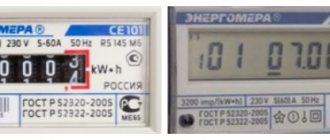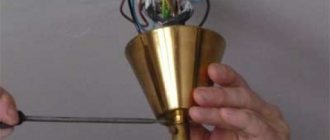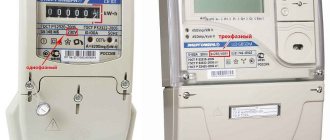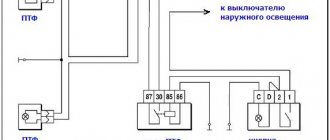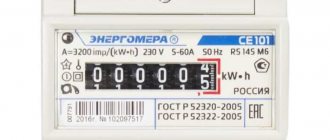It is important to immediately note that installing an electric meter
refers to those types of work that are performed quite rarely, one might say that in exceptional cases. This metering device is highly reliable and has a long service life, therefore, it is not surprising that metering of electricity consumption in many houses and apartments is still carried out using old, already morally and physically obsolete devices. But they, little by little, still fail, and, in connection with this, there is a need to install a new modern device. It should also be noted that the problem of installing an electric meter is also relevant for private developers who are planning to put the constructed facility into operation. But taking into account the fact that the procedure for installing an electricity meter is performed infrequently, for many the problem associated with installing and connecting a new electricity meter can be quite complicated and confusing.
Preparatory stage of work prior to installation of an electricity meter
For several decades, the electric meter was practically the only metering device in a house or apartment. The consumption of electricity used by private individuals has always been subject to strict accounting: payments for gas, heat and water were made exclusively at specially approved tariffs. Special meters were designed to account for electricity, many of which have not only survived and survived to this day, but are also successfully used in modern conditions, although they are noticeably inferior to more advanced and functional devices.
There are several reasons why you need to install a new residential electricity meter
:
- carrying out work to connect the new facility to the power grid;
- planned replacement of equipment due to wear and tear or impossibility of its further operation;
- identification of external deformation of the meter body;
- damage to the seal;
- expiration of the maximum service life of the device;
- repair work on the highway associated with the modernization of equipment, which also involves the installation of modern electricity meters;
- the desire of the consumer to replace outdated equipment with a new one, for example, a multi-tariff device, etc.
But regardless of the reason why the electric meter is being replaced or the initial installation of equipment is being carried out, work should begin with written or oral (including by telephone) notification to the electricity supply organization of your intentions, as well as with the selection of a metering device.
When installing or replacing an electric meter, you should follow Art. 543 and 210 of the Civil Code of the Russian Federation and the norms of housing legislation, and you also need to take into account the norms of Federal Laws: No. 102 of June 26, 2008 and No. 261 of November 23, 2011. In addition, you need to rely on Government Decrees 491 and 530 of 2006.
For example, Article 210 of the Civil Code of Russia states that all work on the installation or replacement of metering devices is assigned to the owners of the premises, that is, to the users of the services. But if the premises are communally owned, then consumers should address this issue to the official owner.
Private houses, as a rule, are owned by citizens, so all work and costs for their implementation are also borne by them. In this case, you should be guided by the norms of Government Decree No. 530 of the Russian Federation, which also specifies the procedure for carrying out these works, namely: the owner of the facility must agree on their date in advance, and he is allowed to do this both in writing and by telephone.
But in order to install an electric meter, you also need to prepare a special package of documents:
- application for installation or replacement of a meter;
- owner's passport (copy);
- documents confirming ownership of the premises. If a third party applies for permission to install a metering device, a general power of attorney will be required;
- technical passport of the electric meter;
- contract for the supply of electricity.
In the event that the electricity meter is replaced, you must also be guided by the norms of the Civil Code of the Russian Federation set out in Articles 541-544 and certain provisions of other regulations. In this case, the procedure requires the fulfillment of several conditions:
- drawing up an act on the dismantling of the old electric meter with recording of its last readings on the day of the work;
- unsealing the device;
- dismantling the device;
- carrying out preparatory work for the installation of a new electric meter (preparing the site, drilling holes, insulating wires, cleaning contacts, etc.);
- installation of a new device.
The final stage, both during the initial installation of an electric meter and when replacing it, is the procedure for putting the device into operation, which necessarily also includes sealing the device. But first you need to contact the regulatory authority, which in this case is usually represented by the electricity supply organization, and submit the following documents:
- statement;
- documented data of the old meter (if replaced);
- technical passport of the new electric meter;
- a copy of the owner’s passport and documents confirming ownership of the premises. But before preparing a package of documents, you should take into account that in some cases they require notarization.
Next, the company specialist seals the device and puts it into operation.
Features of installing an electric meter in a private house
In a private home, in order to install an electricity meter, the consumer will first need to enter into an agreement for the supply of electricity with the regional division of the energy supply company. In this case, the document should indicate both technical data about the construction site itself and its location, as well as information about the purpose of the connection, the required voltage power, etc.
You will also need to provide some documents:
- certificate of ownership;
- project indicating the input circuit breaker assembly and calculation of the rated voltage;
- a plan indicating the installation locations of the meter and a power cable connection diagram;
- grounding project;
- data for calculating the power characteristics of the transformer, connected network and distribution cabinet.
It should be noted that it is impossible for the average consumer to prepare all the documents on their own, since this work must be performed by specialists from companies that have the appropriate license. In this case, help can be obtained from ours and for this you only need to fill out an application on the website rosschet.ru. We also provide services for installing an electricity meter or replacing it.
The law does not prohibit, subject to permission and appropriate documentation, independent installation work, however, the commissioning of the metering device is carried out by a representative of the energy supply organization. At the same time, sealing the electric meter, as well as the procedure for putting it into operation, is free.
ORDER A SERVICE FROM ACCREDITED COMPANIES
How to install an electricity meter
The electric meter can be installed not only indoors, including on the landing, but also on the outer wall of the house, a pole and in some other places that are approved by the licensing authorities. In this case, an important requirement is to maintain the installation height of the device, which makes it easy to use the equipment, maintain it and take readings. As a rule, the meter is mounted at a distance of 800 to 1,700 mm from the floor or ground level.
The actual installation of the meter looks like this:
- the device is installed in a previously prepared place and fixed to the support with bolts;
- Next, the cables are connected to the appropriate terminals;
- after this the meter is sealed;
- The final stage is connecting to the network.
After completion of the work, an Act is signed, which must indicate the serial number of the electric meter, and after that, payment for the consumed electricity is made according to the readings of the new device.
If the old meter is replaced with a new one, the procedure is the same, but it must be dismantled correctly. First, you need to turn off the power supply to the meter and unseal it, documenting the last readings. Next, you should disconnect all the cables and, unscrewing the bolts, remove the device.
Where to install
When installing the meter outside, the following technical requirements must be observed:
- usually, if there are requirements from the provider company, the device is installed on the facade of the house at a height of 70 cm to 170 cm for ease of maintenance;
- It is also practiced to install the meter at the appropriate height on a concrete pole, while it must be located on the territory of the house, and the wiring is installed in the house itself.
The question of whether the requirement to move meters outside is legal is controversial. In fact, there are no regulations regulating the location of the meter.
The energy sales company motivates this by the fact that there should be easy access to the device for control purposes. However, in this case, no one is stopping them from installing a modern electronic device with a remote monitoring function in their home at their own expense and monitoring it at their own pleasure.
At the very least, these requirements are to the detriment of home owners and create inconvenience for them:
- When placed outside, the service life of the meter will be significantly reduced, since this device is not designed to operate in extreme conditions, in the rain, in frost, in heat. At low temperatures, readings may be incorrect.
- When installed on the street, the homeowner will have to put up with the fact that his meter has access not only to company employees, but also to everyone.
- Sometimes, to protect the instruments, they are installed at a height of 3 meters, which, to some extent, protects them from thieves, but the homeowner himself, without a ladder, will not be able to see his readings.
In fact, by forcing citizens to install meters on the street, they are deprived of the right to take care of the safety of their property, as provided for in the Civil Code of the Russian Federation.
This is beneficial for energy companies, as having the instruments outside makes it much easier for them to inspect and test the instruments, as well as take readings of energy consumption.
But this is the external side of the problem, and the flip side is that it will be possible to control not only the readings of the device, but also the connection to the network up to the meter. That is, ultimately, to solve their pressing problems at the expense of homeowners, and on a massive scale.
You may be interested in an article about installing a two-tariff electricity meter.
Read the article on the procedure for calculating electricity consumption standards without a meter here.
How to choose the right electric meter
types of electricity meters can be used for household electricity metering:
:
- induction devices, the operating principle of which is based on simply counting the number of revolutions of the disk. This type of device is well known to all consumers, since all devices used so far belong to this type. They are distinguished by their simple design, ease of use, affordable price and long calibration period. The main disadvantage of these devices is their low accuracy. It should also be noted that their use does not imply the possibility of switching to a multi-tariff electricity consumption metering system;
- electronic devices characterized by compact size and high accuracy. The main operating mechanisms are built-in microcircuits, the functioning of which sometimes malfunctions, which leads to the need for repairs and unscheduled inspections. But at the same time, these meters can be used for multi-tariff calculations, which promises tangible benefits to the consumer, who can choose a convenient and rational mode of power consumption.
However, when choosing an electric meter for installation
in an apartment or house, you need to take into account the features of the facility’s electrical networks and, first of all, you need to take into account the number of phases connected to the house. The location of the device must also be taken into account. For example, electronic meters on the market are represented by products with mechanical and liquid crystal display. For those devices that will be installed indoors, this factor is not particularly important, but for devices installed outdoors or in a cold room, meters with an LCD screen are not the best choice, as they may fail.
a single-phase meter is mainly used
, a distinctive feature of which is the presence of four terminals for connecting cables: one pair each for incoming and outgoing wires.
More rarely, for household metering of electricity consumption, a three-phase meter
, equipped with 8 or more terminals. As a rule, such devices are installed in country houses and cottages, the power consumption of which is much higher, including due to the operation of powerful electrical appliances.
An important criterion for choosing an electricity meter is the accuracy class of the device - for household devices, the measurement error should not exceed 2%.
Kinds
When installing meters outside the home, it is important to choose the most suitable model. In this case, electricity needs must be taken into account. So, for example, if you plan to use equipment that will require three-phase power, then you need to install the appropriate metering device. However, in most cases, in a private house it is enough to install a single-phase electric meter.
Installation on the wall of the house
The operating principle can be inductive or electronic. The first type is considered less effective. It is recommended to choose an electronic type meter for installation. However, induction, although less accurate, is more reliable in operation.
Induction counter
A display or mechanical device can be used to indicate the result. The first option is usually used when installing indoors. The mechanical indication method is considered more reliable; it is preferable for meters located on the street.
Important! Some device options only allow visual readings. However, there are meters that have a built-in modem that transmits data on energy consumption remotely.
Meters may have one, two or more tariff zones. When using them, the tariff at night will be reduced. For the owner of a private home, this will be beneficial as it can reduce the overall cost of electricity used. This is convenient when the area has round-the-clock lighting (for example, if there is a light bulb above the front door).
Electronic meter
When choosing an electricity meter for a private home, it is important for the consumer to pay attention to the following:
- The metering device is provided with a maximum current strength passing through it. Typically this value for a three-phase meter is 32A, for a single-phase meter - 25A.
- You need to choose a high-quality and reliable meter. The company needs to find out the requirements for the device and purchase the most suitable one.
You might be interested in Mercury 201 Electricity meter Transformer: symbol and description
Cheap meters are often inaccurate and have a short lifespan. Repair and reinstallation will cost more than purchasing a quality meter from the very beginning.
Methods for organizing metering of consumed electricity
One of the reasons that the electricity meter is replaced is the consumer’s desire to optimize their energy costs. But since reducing power consumption in modern conditions is an almost impossible task, the only way out may be to switch to multi-tariff payments. But it should be noted that for these purposes, induction single-tariff electricity meters
are not suitable since they are only able to take into account total consumption, regardless of the time of day. One of the reasons for their popularity, which has not been lost to this day, is the low price of the device and its high reliability. But it should be noted that their use is rational only for low or medium power consumption.
Multi-tariff electricity meters are more progressive and cost-effective
which are presented on the market in two types of devices:
- two-tariff;
- three-tariff.
A two-tariff meter is capable of separately taking into account power consumption during the day and at night. The benefits of using such a device can be appreciated by those consumers who most intensively use powerful electrical appliances in the evening and at night. The loyalty of the state when developing tariffs is explained by the fact that in this case the load is redistributed across the operation of power plants and electrical networks, which allows peak loads to be avoided.
Three-phase meters, as well as two-phase ones, allow you to save by redistributing the loads from the operation of electrical appliances depending on the time of day. For such devices, when calculating, three tariffs are applied:
- day;
- night;
- peak.
If such a meter is installed, then the most expensive electricity consumption will be during peak times: from 7 to 10 o’clock and from 20 to 23 o’clock. In this case, the night tariff turns out to be the most profitable.
Requirements for electricity metering devices
To account for electrical energy, metering devices are used, the types of which are approved by the federal executive body for technical regulation and metrology and are included in the state register of measuring instruments.
Technical parameters and metrological characteristics of electric energy meters must comply with the requirements of GOST 52320-2005 Part 11 “Electric energy meters”, GOST R 52323-2005 Part 22 “Static active energy meters of accuracy classes 0.2S and 0.5S”, GOST R 52322- 2005 Part 21 “Static meters of reactive energy of accuracy classes 1 and 2” (for reactive energy - GOST R 52425−2005 “Static meters of reactive energy”).
The main technical parameter of an electric meter is the “accuracy class,” which indicates the level of measurement error of the device. Accuracy classes of metering devices are determined in accordance with technical regulations and other mandatory requirements established for the classification of measuring instruments.
Requirements for metering devices for electrical energy consumed by legal entities:
1. Depending on the value of the maximum power (specified in the delimitation act) and the voltage level at the installation site of the measuring complex, the accuracy class of the metering device must be:
· For points of connection to power grid facilities with a voltage of 35 kV and below with a maximum power (according to the delimitation act) of less than 670 kW - meters with an accuracy class of at least 1,0
.
· For points of connection to power grid facilities with voltage of 110 kV and above, accuracy class of at least 0.5S
.
To account for electrical energy consumed by consumers with a maximum power of at least 670 kW, meters must be used that allow measuring hourly volumes of electrical energy consumption, with an accuracy class of at least 0.5S
, providing storage of data on hourly volumes of electrical energy consumption for the last 90 days or more or included in the accounting system.
(basis of clause 139 of the RF PP No. 442 dated 05/04/2012)
2. The screws securing the meter body must have a seal with the stamp of the state verifier (based on clause 1.5.13 of the PUE).
3. The cover of the meter terminal block must have a seal from the energy supply organization (basis of clause 1.5.13 of the PUE).
4. The metering device must be allowed into operation in the prescribed manner (basis of clause 137 of the RF PP No. 442 of 05/04/2012).
5. The owner of the metering device is obliged to:
· ensure operation of the metering device;
· ensure the safety and integrity of the metering device, as well as seals and (or) visual control signs;
· ensure the taking and storage of meter readings;
· ensure timely replacement of the metering device;
(basis of clause 145 of the RF PP No. 442 of 05/04/2012).
6. The energy supply organization must seal:
current transformer terminal blocks;
covers of transition boxes where there are circuits to electric meters;
current circuits of settlement meters in cases where electrical measuring instruments and protection devices are connected to current transformers together with meters;
test boxes with clamps for shunting the secondary windings of current transformers and the connection points of voltage circuits when disconnecting metering meters for their replacement or verification; grilles and doors of chambers where current transformers are installed;
grilles or chamber doors where fuses are installed on the high and low voltage side of the voltage transformers to which the metering meters are connected;
devices on the drive handles of voltage transformer disconnectors to which metering meters are connected.
In the secondary circuits of voltage transformers to which metering meters are connected, installation of fuses without monitoring their integrity and their effect on the signal is not allowed.
Verified settlement meters must have the seal of the organization that performed the verification on the casing, and the seal of the energy supplying organization on the cover of the meter terminal block.
To protect electrical measuring instruments, switching devices and detachable connections of electrical circuits in metering circuits from unauthorized access, they must be marked with special visual inspection signs in accordance with established requirements.
(Basis – clause 2.11.18 of the Rules for the technical operation of consumer electrical installations)
Requirements for metering electrical energy using instrument transformers:
According to the technical requirements, measuring current transformers must comply with GOST 7746-2001 (“Current transformers. General technical conditions”).
1. Accuracy class
of measuring transformers used in measuring systems for installing (connecting) metering devices must be
at least 0.5.
(basis of clause 139 of the RF PP No. 442 dated 05/04/2012).
2. It is allowed to use current transformers with an increased transformation ratio (according to the conditions of electrodynamic and thermal resistance or busbar protection), if at maximum load
connection, the current in the secondary winding of the current transformer will be at least
40%
of the rated current of the meter, and at
a minimum operating load
- at least
5%
(based on clause 1.5.17 of the PUE).
3. The connection of the current windings of the meters to the secondary windings of the current transformers should be carried out separately from the protection circuits and together with electrical measuring instruments (basis of clause 1.5.18 of the PUE).
4. Use of intermediate transformers
current for switching on settlement meters
is prohibited
(based on clause 1.5.18 of the PUE).
5. The load of the secondary windings of the measuring transformers to which the meters are connected should not exceed the rated values (based on clause 1.5.19 of the Electrical Installation Code).
6. The cross-section and length of wires and cables in the voltage circuits of the calculated meters must be selected such that the voltage loss in these circuits is no more than 0,25 %
rated voltage when powered by voltage transformers of accuracy class 0.5. To ensure this requirement, it is allowed to use separate cables from voltage transformers to meters (based on clause 1.5.19 of the PUE).
7. Instrument voltage transformers in terms of technical characteristics must comply with GOST 1983-2001 (“Voltage transformers. General technical conditions”).
Requirements for metering devices for electrical energy consumed by citizens (individuals):
1. Meters must have an accuracy class of at least 2.0 (based on clause 138 of the RF PP No. 442 of 05/04/2012).
2. The screws securing the meter body must have a seal with the stamp of the state verifier (based on clause 1.5.13 of the PUE).
3. The cover of the meter terminal block must have a seal from the energy supply organization (basis of clause 1.5.13 of the PUE).
4. Metering devices of an approved type and verified in accordance with the requirements of the legislation of the Russian Federation on ensuring the uniformity of measurements are allowed for use (basis of clause 80 of the RF PP No. 354 of 05/06/2011).
5. Equipping residential or non-residential premises with metering devices, putting installed metering devices into operation, their proper technical operation, safety and timely replacement must be ensured by the owner of the residential or non-residential premises.
The commissioning of the installed metering device, that is, the documentation of the metering device as a metering device, according to the readings of which the amount of payment for utility services is calculated, is carried out by the contractor, including on the basis of an application from the owner of a residential or non-residential premises submitted to the contractor. (basis of clause 81 of the RF PP No. 354 of 05/06/2011).
6. Operation, repair and replacement of metering devices are carried out in accordance with technical documentation. Verification of metering devices is carried out in accordance with the provisions of the legislation of the Russian Federation on ensuring the uniformity of measurements (basis of clause 81(10) of the RF Government No. 354 of 05/06/2011).
7. The metering device must be protected from unauthorized interference in its operation (basis of clause 81(11) of the RF Government No. 354 of 05/06/2011).
Cost of installation or replacement of an electric meter
It should be noted right away that the price of installing an electric meter depends on many factors and is not fixed. It is primarily influenced by: the complexity of the work to be done, its volume, as well as the type of device being mounted.
The least expensive option is to install a single-phase induction (mechanical) device. This service, provided by many organizations, costs on average from 1,500 to 2,000 rubles. The cost of installing meters will be higher
with a multi-tariff method of metering electricity consumption. For example, to install a two- or three-tariff device you will have to spend up to 2,500 rubles. The installation of three-phase devices turns out to be the most expensive - their installation costs, on average, from 2,500 to 3,500 rubles.
But when comparing the cost of installing different types of electricity meters, it should be taken into account that the price of electronic products is sometimes several times higher than the cost of mechanical devices. Also, three-phase products are always more expensive than single-phase ones, but in this case the consumer has no choice, since the need to install this particular type of device is determined by the load and the characteristics of the home’s electrical network.
In the event that work related to the installation or replacement of an electric meter is required, we suggest contacting our office, and you can fill out an application by going to the website rosschet.ru.
Meter installation
Before installing an electrical energy meter with your own hands, you should determine the location of its installation and prepare the necessary tools and materials. Electrical goods stores offer a large selection of panels used to install these devices. Both complete sets and individual elements are offered. Meters installed on a finished base, single-phase or three-phase, are very popular.
The choice of the required meter model and protective shield is made based on the connection characteristics and installation location.
Tools and materials needed to install a single-phase meter with your own hands:
- Electric energy meter.
- Protective shield.
- Unipolar low voltage indicator.
- Tools with dielectric handles (pliers and screwdrivers).
- Nuts, bolts and screws.
- Terminal block.
- DIN rail.
- Automatic switches and RCDs.
The electric meter must be installed vertically on the wall. A metal or wooden sheet, as well as a special protected box, can be used as a mounting location for this device. The installation height of the meter is not strictly regulated, but there is a ban on placing them outside the zone of free visual control. The most convenient in practical terms is to install the meters at the height of an adult’s eyes (up to 1700 cm).
Before starting work on installing an electric meter with your own hands, you should carefully study the general wiring diagram of the apartment. This will make it possible to correctly estimate the number and power of consumer groups and, accordingly, the number and type of circuit breakers and RCDs used in the connection diagram.
As an example of connecting a single-phase electric meter, the following diagram can be considered:
When carrying out work on installing the meter yourself, you should adhere to the following algorithm of actions:
- A DIN rail is mounted in the electrical panel using screws, to which all electrical equipment will be attached.
- Using special fasteners or a DIN rail, the meter is mounted to the panel body.
- In specially designated places inside the shield, terminal blocks are installed for connecting neutral working and grounding wires.
- Installation of automatic circuit breakers is carried out according to the number of consumer groups.
- Installation of a residual current device.
- The wires going to the load are connected to the lower terminals of the circuit breakers. The upper terminals of the machines must be connected to each other using jumpers, which you can make yourself or purchase at an electrical goods store.
- The electricity meter is connected to the load; for this, its second contact is connected to the phase wire, and the fourth to the neutral wire.
- To connect the meter to the network, it is necessary to connect its first contact to the incoming phase wire, and the third to the corresponding neutral conductor.
To facilitate the further operation of the devices included in the electrical panel, it is necessary to draw up a diagram indicating consumers (sockets, light switches, washing machine, electric stove, etc.) and also mark the wires connected to the meter and switches with appropriate markings on the diagram .
